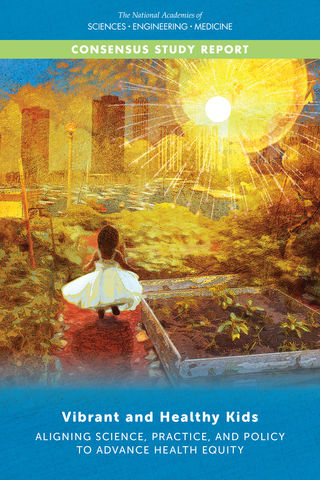
Resilience
Resilience in Childhood: New Insights
A national report declares youth at high-achieving schools to be "at-risk."
Posted March 11, 2020 Reviewed by Gary Drevitch

In the last few months, there have been two important shifts in scientists’ thinking about critical issues in children’s risk and resilience. Both are clearly described in a comprehensive consensus study from National Academies of Sciences, Engineering, and Medicine, "Vibrant and Healthy Kids," that is focused on enhancing equity in children's well-being. In this post, I’ll discuss the first of these shifts in thinking about risk and resilience, and will describe the second in my next post.
The first change has to do with which kids are thought about as being “at-risk” for maladjustment given challenging life circumstances; included, now, are children who are the focus of this blog, Privileged but Pressured. Specifically, the report describes students at high-achieving schools (HASs) as an at-risk group, along with others traditionally considered vulnerable including children in deep poverty, those in foster care, and those with an incarcerated parent.
It's important to clarify that “students in high-achieving schools” isn’t directly synonymous with “affluent students." The group referenced includes students attending schools with good test scores, rich extra-curricular and college-level offerings, and graduates heading to selective colleges. Most students at such schools are from white-collar professional families, but there is always some diversity in backgrounds.
Pathways to Distress
Why do high-achieving schools connote risk for serious levels of symptoms of depression, anxiety, and substance use? My colleagues and I have described these factors in detail in a recent American Psychologist article; here, I summarize some of the major issues.
At the core of the problems are ongoing, powerful pressures for these children to achieve ever-more; to distinguish themselves as among the very best among a group of highly accomplished schoolmates. As the global job market has grown more competitive, attendance at a top university has increasingly been seen as a prerequisite for securing a high-paying job. This has led to increases in applications to top universities and lowered acceptance rates. In fact, acceptance rates at the top 10 universities decreased by 60% in the last 12 years, and 37% across the top 50 universities.
In part because of resources and opportunities available to them, students in high-achieving schools tend to live by the mantra, “I can, therefore I must." They feel they must take on that one more challenging course, that second or third extra-curricular commitment, in order to be among those most competitive. As a result, these youngsters are overworked to the point of exhaustion. All the evidence from science points to an urgent need for parents, teachers, and students to take a step back, consider the child’s overall workload, and ask, “How much is enough?”
Also contributing to the high distress in high-achieving schools are technological advances, which have made it easier than ever for students to compare themselves with others. Our data show that comparisons on social media are especially problematic, with girls being particularly susceptible. Many students see the curated self-image that their peers project outwardly, and do not appreciate the struggles and failures behind the scenes.
What can we do to help?
How do we support these students and reduce serious problems of mental health? The answer lies in helping to strengthen the bond between these kids and those closest to them in everyday life: their parents, teachers, and peers.
Some in the field believe that students’ mental health is best improved by focusing on their personal coping skills and possibly promoting “growth mindsets." But this is not supported by research. In fact, science says that the single most important “protective factor” in doing well despite stress is having access to strong, supportive relationships. If we are to meaningfully improve our children’s well-being, we must first focus on strengthening the safety nets of supportive relationships in their everyday lives.
Parents will need to prioritize having relaxed down time with their children. With jam-packed schedules, they’ll need to ensure time for ongoing, open communication with their kids, and for directly conveying affection and support. Also, parents must be watchful for words or actions that kids see as being too critical or harsh; negative interactions have a greater impact on relationships than do positive or kind interactions.
Schools can further help their students by addressing practices that exacerbate comparisons. In my own work with schools, one example I’ve come across repeatedly is the tradition of “sweater days” wherein students wear the sweater of the college to which they’ve been accepted. While this day undoubtedly excites students who’re accepted to their dream schools, it also can lead to feelings of shame in those who didn’t receive acceptance to their top (or even second or third choice) college. Such deliberate, public shows at school of “winners versus losers” is both unhealthy and unnecessary.
Finally, it’s really important for schools to do thorough, research-based evaluations of their own students and school climate. There are certainly stressors that are common across high-achieving schools, including those I’ve already mentioned. At the same time, each school is unique, bringing its own set of strengths and challenges; these will need to be defined, identified, and systematically targeted using methods and measures validated in science.
Given my own professional foci over the years, I was thrilled to see these issues highlighted in the 2019 NASEM report. My research team and I have argued for over two decades that there are many serious challenges facing children at “the good schools” (this represents at least 25% of all children; those in the top quartile of standardized test scores). As these children have now been brought to national attention in an important consensus study, there’s hope that we’ll see more systematic consideration of the well-being of this group of youth and their families.
Part 2 of this post will be focused on families and other important adults.



